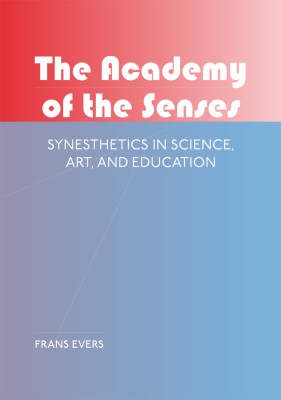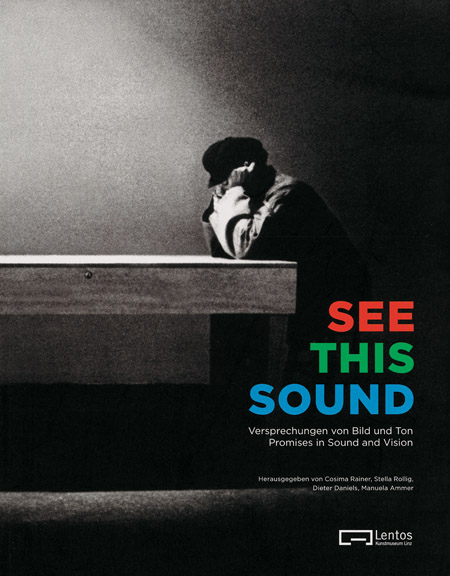Frans Evers: The Academy of the Senses: Synesthetics in Science, Art, and Education (2012)
Filed under book | Tags: · art and science, art education, art history, education, electronic music, media art, remediation, science, sound, synaesthesia, theatre

“Frans Evers’s The Academy of the Senses is a book wanting to be three books at once. A study of the scientific approaches to synesthesia, related to the psycho-physical research conducted by Evers during his studies at the university; an alternative art history of the twentieth century based on the double paradigm of Castel’s clavecin oculaire and Wagner’s Gesamtkunstwerk; and a full account of the genesis of the Interfaculty Image & Sound. To encompass this entire range of subject, Evers coined a new term, “synesthetics,” to denote the experience, creative force, and study of synesthesia.
Throughout his career, Evers profiled himself as an educational reformer. Together with electronic music pioneer Dick Raaijmakers, he started a series of projects and lectures exploring the interaction of music and fine arts, which culminated in the establishment of the first multimedia department in the Netherlands, the Interfaculty Image & Sound at the University of the Arts in The Hague, which Evers headed from 1989 until 2007. This book maps out the theoretical and artistic foundations of this educational reform project, as well as its synesthetic output: large multi-media performances such as a reworking of Anton Schoenberg’s Die Glückliche Hand, Mondrian’s Promenoir, and Scheuer im Haag.
The Academy of the Senses is a “source book,” a work of inspiration, rather than a rigid account of historical facts. It provides anyone with an interest in the wondrous realm of multimedia arts and synesthesia as a creative force, whether student or professional, an introduction into the foundations and extensions of seeing sound and hearing colors throughout the centuries.”
Compiled and edited by Vincent W.J. van Gerven Oei
Publisher ArtScience Interfaculty Press, University of the Arts, The Hague, 2012
ISBN 9789461908193, 9461908199
298 pages
via editor
Review: Matteo Marangoni (Neural, 2013).
PDF (19 MB)
Comment (0)See This Sound: Versprechungen von Bild und Ton / Promises in Sound and Vision (2010) [German/English]
Filed under book, catalogue | Tags: · art, art history, audiovisual, avant-garde, cassette culture, dance, electronic art, experimental film, film, fluxus, music, music history, performance, performance art, sound, sound art, synaesthesia, video, video art, vision, visual music

“As the status of sound in art and music evolves and redefines itself, so too does sound art find new ways of describing its history. See This Sound compiles a large number of artists, filmmakers, composers and performers, reaching back into the early twentieth century and into the present to survey overlaps between not only sound and art, sound and film, and the metaphor of cinema as rhythm or symphony. Proceeding chronologically, the book takes the early cinematic “eye music” of Hans Richter as a starting point, noting parallel works by Walter Ruttmann and Oskar Fischinger; moving into the postwar period, the art/cinema/ music experiments of Peter Kubelka, Valie Export and Michael Snow are discussed, establishing precedents to similar work by Rodney Graham, Carsten Nicolai, Jeremy Deller and many others.”
With essays by Helmut Draxler, Diedrich Diederichsen, Gabriele Jutz, Liz Kotz, Heidi Grundmann, Christian Höller, Dieter Daniels, and Manuela Ammer.
Edited by Cosima Rainer, Stella Rollig, Dieter Daniels and Manuela Ammer
Publisher Walther König, Cologne, 2010
ISBN 3865606830, 9783865606839
320 pages
Exhibition website and archive
PDF (19 MB, updated on 2021-7-19)
Comments (7)David Crowley, Daniel Muzyczuk (eds.): Sounding the Body Electric: Experiments in Art and Music in Eastern Europe 1957–1984 (2012) [English/Polish]
Filed under book | Tags: · 1950s, 1960s, 1970s, 1980s, art, art history, avant-garde, central europe, east-central europe, eastern europe, electroacoustic music, experimental film, happening, sound, sound art, synaesthesia, video art, visual music

“In the aftermath of Stalinism, composers and artists in Eastern Europe were given new opportunities to experiment. New recording studios equipped with magnetic tape recorders and later, synthesizers were established, first in Warsaw in 1957 and then throughout Eastern Europe. New and often challenging forms of music were produced in these laboratories of sound.
The connections between the visual arts and experimental music were closer in the 1960s than perhaps any time before or since. Sound and image combined in artists’ films, ‘happenings’ and sounding installations. Experimental forms of notation were also created to stimulate uninhibited musical expression.
The early happenings and actions of the 1960s were associated with intellectual freedom and reform. The exhilaration of experimentation declined during the decade and in the 1970s new critical forms of art emerged which associated sound with surveillance and censorship.
This book accompanying an 2012 exhibition at the Muzeum Sztuki in Łódź explores both the optimism and the anxiety that was to be found in the experimental zone of art and music.”
The exhibition later moved to the Calvert 22 Gallery in London.
Artists: Collective Actions, Walerian Borowczyk, Andrzej Dłużniewski, Szábolcs Esztényi, László Vidovszky, Krzysztof Wodiczko, Grzegorz Kowalski, Zygmunt Krauze, Henryk Morel and Cezary Szubartowski, Eugeniusz Rudnik, Bulat Galeyev, Milan Grygar, Milan Knížák, Oskar Hansen, Zofia Hansen, Zoltán Jeney, Vitaly Komar & Alexander Melamid, Katalin Ladik, Jan Lenica, Dóra Maurer, Vladan Radovanović, Józef Robakowski, Bogusław Schaeffer.
Dźwięki elektrycznego ciała: Eksperymenty w sztuce i muzyce w Europie Wschodniej 1957–1984
Publisher Muzeum Sztuki, Łódź, 2012
ISBN 9788387937980
222 pages
David Crowley’s presentation at MoMA (video, 50 min)
Sounding the Body Electric: A Conversation (Michał Libera, Art Margins)
Accompanying audio 2-CD
PDF
PDF (exh. guide, Calvert 22 Gallery, London, 2013, added on 2023-12-27)

